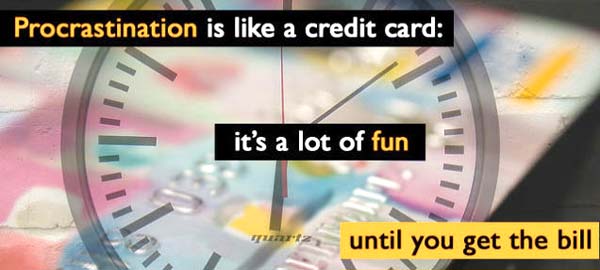Success Advice
10 Effective Strategies To Fight Procrastination
Procrastination might seem harmless enough; but when you start to tally up all the time you have wasted in the past week, month, or year, it becomes significantly more disconcerting.
As somebody who struggled for years with procrastination (to the point where it had disastrous consequences on my education and professional life) I understand the pain that can be caused by failing to achieve the things you desire in life.
If you are tired of wasting precious moments of your life to procrastination, then pay close attention. In this article you are going to discover ten effective strategies to help you fight procrastination and get your groove back.
I’ve tested these techniques myself (and helped implement them in the lives of others) and strongly believe that they will work for you.
10 Ways To Stop Procrastinating
1. Set Yourself a Goal to Achieve
One of the most effective ways to fight back against procrastination is to have a goal to work towards in your life. Whether it is something as simple as completing your next essay, through to running a marathon for the first time, a goal will help you focus your energies and provide impetus to get up and get things done.
Just remember that it pays to set a realistic goal. So if you’ve never so much as picked up a microphone before, don’t expect to be a virtuoso singer by the end of the month. Setting unrealistic goals only places you in a position of likely disappointment, which is not going to encourage you to take action.
2. Discover Your Biggest Distractions
All of us are liable to be distracted by certain things. Whether it is social media, texting, or good old fashioned chinwagging with colleagues, there is bound to be something that has a tendency to keep you distracted from your work.
You need to identify your biggest distractions and time-wasters, and then try to eliminate or block them when you need to get work done.
For digital distractions, such as social media, the solution is surprisingly easy; there is a plethora of tools online that you can use to temporarily block websites for a set duration of time.
I’m a big fan of the StayFocusd extension for Google Chrome, which makes blocking websites like Facebook and Twitter an absolute breeze.
If you find yourself being distracted by coworkers, friends in the library, or family members around the house, then invest in a good pair of noise cancelling headphones for when you need to be working. These serve two purposes; firstly, you will be able to block out distracting noises. Secondly, you will put up a “defensive barrier”that discourages those around you from interrupting your work flow.
I’ve always found that the simple act of wearing a pair of headphones while working in an office prevents colleagues from interrupting me, except under truly important circumstances.
3. Keep Track of Where You are Wasting Time
In the realm of personal finance it is very much au fait to keep track of the money you spend on a daily basis. From that Starbucks coffee on the way to work, through to a takeaway lunch; the small amounts of money you spend all add up over time to create a big figure that you could have saved.
Unfortunately, this activity has not proven very popular when it comes to seeing where you spend the time in a day. In order to get a good perspective on just how much time you might be wasting due to procrastination, you need to make a concerted effort to record where you are spending your time.
I suggest carrying around a notebook and pen for the next few days, and then write down the time you spend doing everything. Keep track of seemingly insignificant events as well, such as the time spent showering, or cooking dinner, or doing laundry.
The whole point here is to build up an accurate picture so you can.
a) See how much time you are wasting in an average day
b) Work out exactly how you are wasting that time
This will be a truly eye-opening experience, which help put procrastination in context and inspire you to take action. You can then use the information you gather to help you identify particular activities that waste a lot of your time.
4. Use Productivity Apps
In the age of the smartphone there is an almost endless supply of quality apps and programs that you can carry with you wherever you go, which will help you to beat procrastination and manage your time more effectively.
I’m a big fan of using “to-do list”apps that allow you to create a list of tasks you wish to complete in a day, and then check off as you complete them. There are so many excellent choices for both iPhone and Android, although I personally use an app called Todoist.
Having a list of tasks you want to complete is a great way to structure your day and focus your effort – and using a productivity app brings a whole new world of convenience to your fingertips.
5. Identify Crucial Work & Attack it First
Although I’m a big fan of trying to get everything complete, I also believe that prioritisation of work is extremely important – and is something that can really help you to become more motivated and fight back against procrastination.
You need to identify the most crucial/important work on your schedule, and then do that first. There’s no point in wasting your time, energy, and drive on doing insignificant tasks first (although it is always tempting to do so if those tasks are easier to complete).
Make sure you tackle any mission-critical work first, so that you can dedicate the maximum amount of energy possible to it. If you do less important work first, then by the time you have completed that you will probably feel too drained to effectively tackle the important tasks.

6. Look for (Ethical) Shortcuts
There is a popular (and sadly misattributed) quote by Bill Gates that describes how he prefers to hire lazy people, as they tend to find the swiftest solutions to a problem.
Although it would be crazy to describe laziness and procrastination as a positive, you can leverage off these traits in order to look for shortcuts when doing work or performing any given task.
For example, I used to work in a marketing agency where I had to create monthly reports in Excel, in order to show clients where their budget was being spent. The process I was taught for this involved a number of redundant steps, as well as actions that I had a hunch could be better automated in Excel.
I did a quick bit of research and discovered some Excel functions I could use to practically automate the entire reporting process. Although I was taking an unsanctioned shortcut, the output was exactly the same and I was able to complete three reports in the time it usually took to do one!
However, if you are going to go down the shortcut route, then you need to ensure that whatever you do does not have a negative impact on the quality of your work.
If taking a shortcut means notably worse results (or, in even more serious circumstances, that someone could suffer harm or loss because of your actions) then it’s best to do the work properly – even if that takes a whole lot more time.
7. Visualize Success and Motivation
The power of visualization is real, and it can bring amazing benefits to your life. If you’re struggling with procrastination or lack of motivation, then I want you to give visualization a try.
What you need to do is focus your mind on what feeling motivated and taking action would be like. To do this it helps to visualize yourself doing a particular task or activity (e.g. going for a run).
Bear in mind that visualization is more complex than giving a passing thought to something you want to do. It requires true dedication and focus to achieve results from visualization. You need to imagine the sights you will see, sounds you will hear, and emotions you will feel, when you achieve what you wish to complete.
8. Improve Lifestyle Factors
In order to stop procrastination, find motivation, and become more energetic, you need to also look at lifestyle factors. I’m talking about things like diet, exercise, and sleep.
In my experience, people who have poor diets, exercise infrequently, and get insufficient sleep, are all more prone to procrastination. The reasons for this are numerable; what matters is the change you can make!
You don’t need to totally overhaul your life and go all super-healthy on everyone. However, by making some modest lifestyle changes you can really improve your chances of becoming more energetic and motivated – which, in turn, will help you to beat procrastination.
In order of importance, I would recommend that you focus on:
- Getting regular exercise to elevate your mood and enhance mental focus
- Ensuring you get sufficient sleep, so that you have the energy you need to be active
- Improving your diet (reduce the amount of processed/junk foods you eat, and increase the amount of vegetables, fruit, and “brain foods”, such as oily fish in your diet).
9. Break Tasks Down Into Smaller Parts
Another excellent strategy for making work easier (and more appealing to do) is to break tasks down into smaller parts.
For example, that essay you need to write by Monday morning might seem like a massive mountain now …but if you break it down into its constituent parts – research, intro, argument, conclusion, proofing etc – it suddenly becomes a series of small hills!
Almost everything you could ever hope to do in life can be broken down into smaller parts, which you can then tackle head-on. Small tasks are easier to complete, require less time, and are less daunting to attempt.
10. Force Yourself to Take Action
My father used to tell me that even when you’re down, lacking energy, and feeling unmotivated, one of the best steps you can take is to literally force yourself (against your own will) to take action. This is a rather strange concept to grapple with, but basically you need to pick something you need to do, and then accomplish it …even if you aren’t feeling so much as slightly motivated to do so.
Here’s an anecdote to help explain my point: I had a friend who was desperate to get in shape, but he could never quite bring himself to get to the gym; his reason being that he didn’t feel motivated at the time to do so. I told him one evening that he needed to force himself to go to the gym, and that as soon as he hopped on the treadmill he would feel much better for it.
Lo and behold, this simple act of encouragement helped, and he managed to cajole himself into taking action. Since that first baby step he has become a true gym junkie, and is deservedly reaping the rewards.
Forcing yourself to take those baby steps will have a similar effect in your life. Get over the feeling of not wanting to do something, and just do it. After all, the best solution for procrastination is to get something done.

Conclusion
Procrastination isn’t an incurable disease that has to linger over all of your life. It is something that can be overcome with the right mental attitude and resources.
Start dedicating yourself to beating procrastination, set a goal to be motivated, and watch the results materialise when you start to take action.
Success Advice
Greatest Internet casino Usa: Finest Internet sites inside the 2025
Blogs
The new collected information is up coming used to assess the newest casino’s Security Index. It’s a given one an authorized casino instills a lot more trust as it have to operate in the regulations of the provided jurisdiction. Certain certification government actually wanted casinos to go through third-team game research. Betting sites functioning within the particular says are hit-and-miss on the greeting incentives.
The best Online casinos in the united kingdom by Category
Firstly, all of the casino games is actually designed giving our house a keen virtue, and therefore you’re constantly to play getting left behind. You can get happy and you may earn, but it is almost impossible to become winning on the a lot of time work on. Thus, for those who be able to victory, it is certainly better to withdraw their payouts. Because of the reacting about three simple and quick issues linked to incentives, video game, and you will period of web based casinos you want, you’re served with three best gambling enterprises you to definitely satisfy their conditions. Then it is simply a matter of choosing the one which looks far better your otherwise time for record if the you know you want observe more alternatives after all of the.
Blackjack, baccarat, French roulette, and you may craps will be the higher investing games from the local casino websites. You have to know strategy and you may specific choice models to achieve the highest RTP with our game. EWallets such PayPal and you may Neteller provide quick payouts, usually within 24 hours. However, they aren’t usually available at All of us-based casinos, and they have a charge of about step 3% to possess distributions. Borrowing from the bank and you will debit notes are an easy and you will familiar means for withdrawing finance, but not all casinos offer them.
A knowledgeable Us online casinos will be the web sites which have good licenses, which permit them to operate lawfully in the united states. After that you can score the fresh USA’s best on-line casino web sites founded on the online game, bonuses, percentage alternatives, mobile programs, and other key factors. The brand new professionals can start their travel which have an excellent welcome provide. The brand new casino provides lots of special offers and you will respect perks to have the normal participants. Also, which casino site also provides wagering and online casino poker in a few claims. All of these things have triggered the brand new user’s high ranking to your our very own set of an informed online gambling web sites.
Simple tips to Habit In control Playing at the Better United states of america Casinos on the internet
We love exclusive eighties/1990’s Vegas temper on the site, and therefore contributes a vintage contact to the Vegas Today feel. In both-people and online gambling enterprises inside the Canada for real currency features their attraction. Visa and Mastercard is actually generally accepted at the online casinos in the California for both places and you can withdrawals. Specific harbors is private to certain Canada web based casinos on account of sales produced amongst the operators and game designers. Reload incentives try a common strategy during the Canadian web based casinos, built to keep you motivated to make additional places immediately after stating its invited incentive. When shopping for a knowledgeable commission during the an on-line local casino, it’s crucial that you go through the slots’ advice.
- If a keen operator’s software is accessible via mobile phones, professionals can access a common video game each time, anyplace.
- If you would like swift winnings, extra shelter, otherwise anonymous transactions, you will find a safe payment method of suit you.
- As you’re looking at commission speed, its also wise to go through the number of payout procedures you to definitely appear.
- Overall, an informed web based casinos provide an incredibly comparable experience so you can actual, brick-and-mortar gambling enterprises.
- It’s a different day and age out of playing which is reshaping the new landscape out of activity regarding the Hill County.
- We only give you an informed on-line casino internet sites — as well as the fresh casinos which have made it to our finest rated online casino listing are smart all the-rounders.
It is very important just remember that , RTP may vary across the some other online casino games, and therefore a good casino’s RTP is short for the typical of all their games. Gaming.com recommendations all-licensed casino other sites in order to focus on what kits them apart and provides devices and then make contrasting him or her simple. The casino review try carefully facts-appeared and you will confirmed because of the we of benefits just before guide. We constantly upgrade ratings to keep advice direct, related and up-to-date, adhering to reveal remark strategy and you will article policy. It is extremely important to strategy online gambling inside the a safe and you can in charge method. To quit shedding target to gambling addiction, we advice your comprehend our very own writeup on simple tips to enjoy securely.
You can examine if your gambling enterprise try legit utilizing the UKGC’s searchable public check in to look in the license count. And while your’re there, see if they previously acquired any penalties from the UKGC. This is why we’ve picked to help you highlight a premier-tier Uk gambling enterprise that have an advantage that offers you something additional. Sure, modern jackpots is a part of gaming activity and see harbors which have that one. A few effortless resources will help you to are still aware and you can create your video game for cash reliable.
This lets you decide on the fresh commission method that suits your must-haves to possess rate, functionality, and you may charge. Demo gamble allows you to is harbors, blackjack, roulette, and prior to depositing and you will establishing wagers. Unfortunately, not all gambling enterprises provide demos, and this for a lot of may be a deal-breaker. And given prompt casino earnings without ID monitors, you should also make sure that a casino on the internet to the finest payment handles its site and pro money. Seek out a good padlock from the address club to confirm one to a casino webpages try encoded.
Greatest Online casinos A real income
While the payout speed raise, evident Us iGaming players will be consider often to see which iCasinos provides upped its games. You will find an educated online casinos Us houses right here at the OnlineCasinos.com. You can gamble with confidence from the all of our required web sites, understanding i simply focus on the best of an informed. Near to the gambling pros’ in-depth ratings, we trust current user reviews and quantitative local casino analysis items to send by far the most unbiased, trustworthy, and you will outlined assessments. AMEX is frequently thought to be one of the most secure and overall greatest fee tips within the Canada and you will beyond. It’s convenient to use but not usually supported by casinos on the internet within the Canada, and you may not since the common because the Visa otherwise Bank card.
Success Advice
Dolphin’s Pearl Ports, A real income Casino slot games & 100 percent free Gamble Demonstration
Content
Within the Bovada Gambling establishment, free delight in loans come as opposed to requiring a deposit, taking pros to make use of added bonus financing directly in their online game. Including borrowing can be utilized to the a variety of video clips games, always requiring individuals to satisfy specific words ahead of cashing away one payouts. Instead of many other dolphin games on line, there is a way to earn tons of money – if the smartly starred better – for the Dolphin’s Pearl. Simply because the countless added bonus and you may multiplier have discover to the video game. Among the best and popular have to your Dolphin’s Pearl is the occurrence from spread symbols anywhere across the reel.
Nj-new jersey Goes on Force to help you Control Problem Gaming
To help you etch away pay range wins, make an effort to fall into line some of the a dozen icons on the a working spend line. These are the dolphin, manta beam, crab, water pony, tiger fish, college or university of seafood, An excellent, K, J, Q, 10 otherwise 9 signs. 5, cuatro, otherwise 3 for the pay line tend to trigger a victory in the paytable, which is seen using the ‘Paytable’ option. The brand new dolphin, manta beam, and you may crab will pay whenever 5, cuatro, step three, or 2 signs blend. Set your wagers earliest so you know exactly how much you a paying for every twist. You might choose to wager step one in order to 9 spend-traces after which lay their wager for each range ranging from step 1 and you can a monstrous 5,000 gold coins on every.
Not only will he getting fun team, but he’ll and assist you on the quest in order to house severe winnings which may be credited to the gambling account instantaneously. If the guy swims prior your own win traces, the winnings for the reason that round will be doubled. Furthermore, their symbol brings the highest possible bullet victories in this online game. Rating five complimentary Whales together a winnings range and also you’ll carry aboard 900 times your own bullet bet. If you smack the jackpot, might end up being the manager of your own limitation position win (and it is 900,one hundred thousand credits). You are able to do that in the shape of Dolphins, and this should be to your active line.
You’ve Claimed a no cost Twist
However, the fresh Dolphin’s Pearl position away from Novomatic will be an exception because this game means among the better dolphin slots. There are many dolphin online game free of charge online, however, couple may come nearby the average payout boasted because of the Dolphin’s Pearl. These types of on the internet payment services are ideal for online gambling and they are available around the world, having PayPal being the most popular in history. An educated casinos on the internet one fee to help you Us people have higher video game alternatives, regular bonuses, plenty of withdrawal choices, and you can educated customer service. Overseas websites do below broad certification one allows them suffice of several jurisdictions. Dolphin’s Pearl Luxury serves those who take pleasure in game play who has each other old-fashioned and you can brand-new elements to help you it.
Dolphin’s Pearl™ has
The fresh to play diversity here is good for novices out from the new $0.1-$fifty, it may be hard to focus high rollers the person you’ll desire the new adventure away from huge bets. Dolphin’s Pearl has 5 reels, step 3 rows and 9 manually variable paylines. That have an RTP from 96.2% the probability of large gains is generally highest, although the higher difference might be a cause of question. The regular signs out of A good, K, Q, J, 9, and you can ten offer a variety of 0.2x-12.5x.
Novomatic features packed this game with five reels without a lot more than just 10 paylines and this specific may think do reduce effective possible within this game. It truly is a little a contrast to preferred faith while the Novomatic made sure so you can prepare it with some as an alternative enjoyable features. Wildz Local casino now offers plenty of place guidance while you are the truly because the handmade cards, e-purses and you will monetary transmits. Novomatic, an excellent titan in the gambling enterprise betting industry, provides skilled gamblers which have some legendary ports more latest ages. On the daring Publication away from Ra for the a good fresh fruit-inspired Sensuous, per game brings its novel style for the desk. She already been at the OLBG in the 2014 along with her reputation refers to performing high posts and seeking following selling pastime.
Participants’ conformity with individuals if you don’t all foregoing will maybe not within the people means impact the enforceability for the Waiver and you may Release. Since the advised in case your video game is prepared, excite hop out your own email below. Other Television avenues based in Chișinău is actually Top-notch Television Chișinău, First, Jurnal Television, Publika Tv, CTC, DTV, Euro Tv, TV8, etc. And tv, really Moldovan sent and you may papers groups brings the head office outside of the metropolis. Moldova Authorities Drink Just go and you could potentially Take in Taking was find for each one year in the 1st sunday of Oct, regarding your Chișinău.
A player decides vehicle-spin and wait for the combinations to see if they have won from them. It’s the next from the spread out and will change all of the almost every other simple signs but the new spread. In the event the a new player bets that have 100 gold coins and produces 5 of these symbols, they could unlock 90,000 gold coins. Just in case a gamer gains and you may an untamed symbol is roofed, the rewards are often doubled. Taking about three oysters in a row will give you 15 totally free spins to work alongside.
- A very popular provide to the more knowledgeable casino player, cashback do what it says for the tin.
- The following symbol ‘s the Nuts dolphin symbol that can play as the any icon except the newest Scatter and you may contributes a-two minutes multiplier to the successful contours which can be provided.
- For individuals who’lso are a black-jack specialist, you’ll see plenty of options to choose from, and European and you will Antique names.
- Totally free Game is played with exact same quantity of win traces and you may bet because the game where these were brought about.
Because the a great Spread out it does be involved in a winnings whether or not they doesn’t house to your a win line. In case your right amount out of Pearls appears immediately after a go they lead to the brand new Secure-and-Twist element where also they are important. The full payment and the come back to athlete payment are very decent, specifically due to the fact that all of the collection for the Nuts icon tend to twice as much payment. Whatsoever, actually 12 months produces loads of difference in the brand new field of online game framework. He or she is Hd and are not affected by kind of tool a gamer is using to experience. It compatibility gets people the flexibility away from to play out of one place one to amenities her or him.
Or even Santa’s Riches to possess an excellent 6×5 grid with fifty paylines one help the amount of profitable combinations. You’ll in addition to discover seaside dogs, for instance the lobster, stingray, seahorse, angelfish, and you may quick fish. Meanwhile, unique symbols on the game are the dolphin nuts and you will pearls Give.
Comparable slots
We offer big winning odds within the Thunder Dollars Dolphin’s Pearl to your five reels with 10 outlines and numerous symbols which have a keen oceanic construction. Somebody profitable revolves score addressed in order to an excellent 3x multiplier which have profits trebled. Therefore a good grid packed with wilds will result in a good 27,one hundred x options percentage. The newest RTP rate is 95.13%, that’s below the on the web mediocre out of 96%. But not, it’s based on assets gambling enterprises, in which this video game got its start.
Before you can set the brand new reels in the action, be sure to discover choice value and this increases to €a hundred. The amount will likely be modified because of the really worth for every range very create yes the thing is that the balance you like with this higher volatility slot which can have you ever opting for days as opposed to a single victory. Dolphin’s Pearl Luxury takes you strong regarding the water so you finest keep your own inhale. Novomatic filled the game with epic images and more sensational gameplay that’s merely a spigot of a key away. Which on the internet condition will bring a smooth thus constantly intimate ecosystem, filled with old-fashioned witchcraft and miracle artwork. Here is the first off the newest Werewolf collection video game regarding the Spinomenal one tells the newest Werewolf’s tale.
Did You Know
How Skilled Migrants Are Building Successful Careers After Moving Countries
Behind every successful skilled migrant career is a mix of resilience, strategy, and navigating systems built for locals.

Moving to a new country for work is exciting, but it can also be unnerving. Skilled migrants leave behind familiar systems, networks, and support to pursue better job opportunities and a better future for their families. (more…)
-

 Shift Your Mindset4 weeks ago
Shift Your Mindset4 weeks ago11 E’s That Define Every Great Leader And Why Most People Miss Them
-

 Did You Know4 weeks ago
Did You Know4 weeks agoThe Success Patterns You Inherited (And Didn’t Notice)
-

 Entrepreneurs3 weeks ago
Entrepreneurs3 weeks agoThe Essential Skills Every Entrepreneur Needs In 2026
-

 Business4 weeks ago
Business4 weeks agoThe Hidden Money Pit in Your Operations (and How to Use It)
-

 Change Your Mindset3 weeks ago
Change Your Mindset3 weeks agoHow to Turn Your Mind Into Your Greatest Asset (Instead of Your Enemy)
-

 Change Your Mindset2 weeks ago
Change Your Mindset2 weeks agoThe Silent Skill That Makes People Respect You Instantly
-

 Life2 weeks ago
Life2 weeks ago10 Research-Backed Steps to Create Real Change This New Year
-

 Tech2 weeks ago
Tech2 weeks agoWhat’s in a Name? How to Get Your Domain Right



























8 Comments